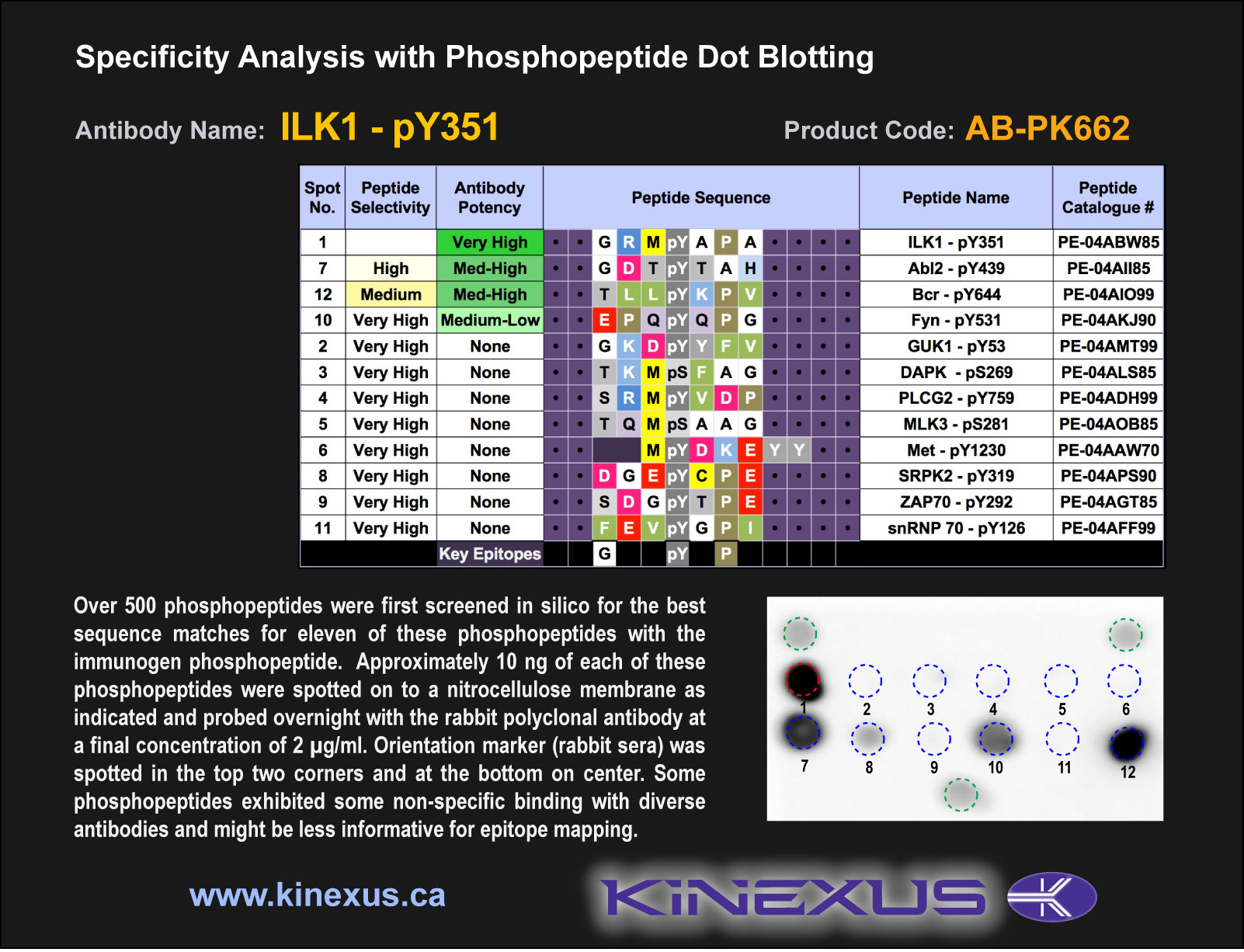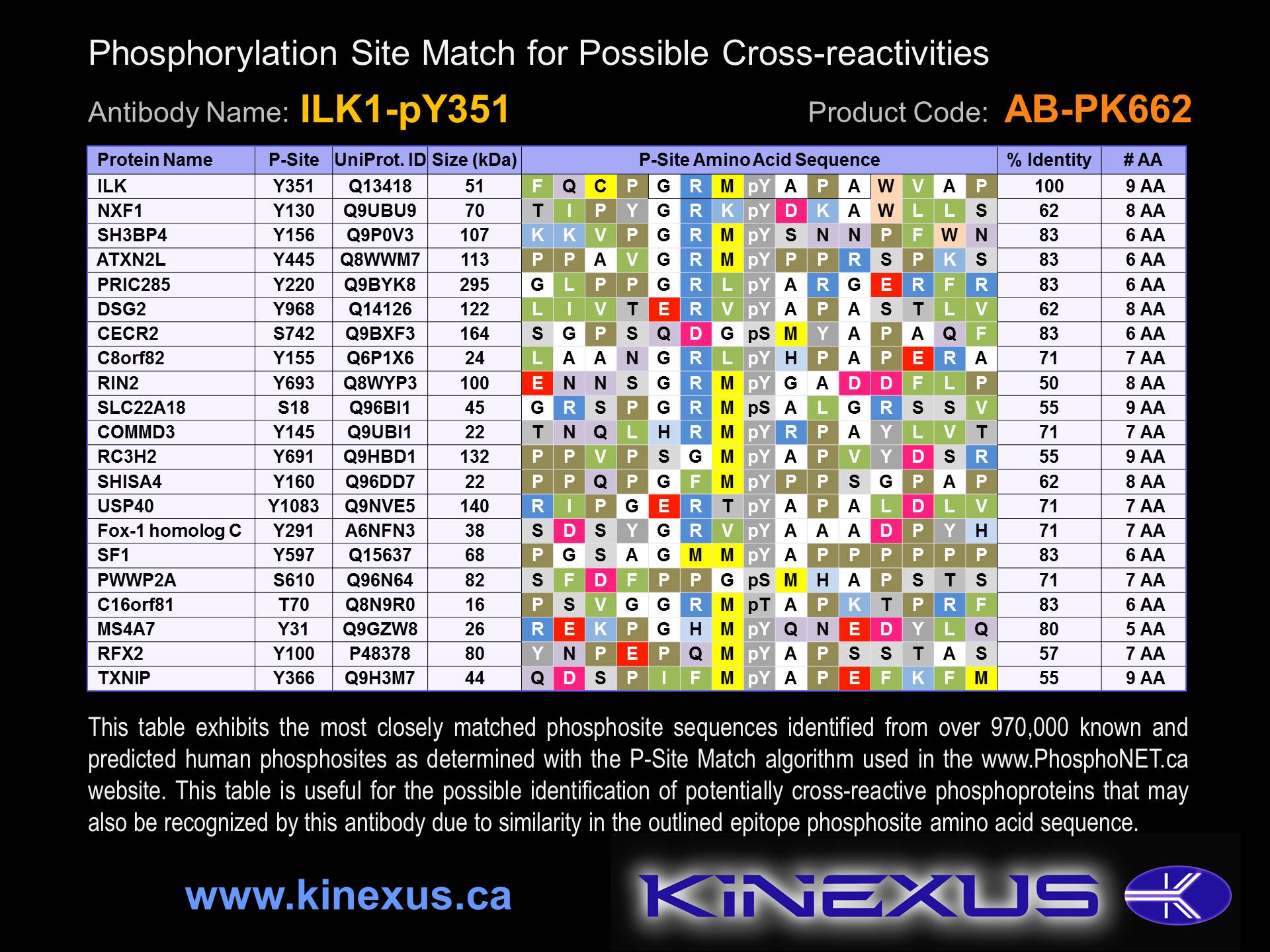Product Name: ILK1-pY351
Product Number: AB-PK662
| Size: | 25 µg | Price: | 89.00 | |
| $US |
Target Full Name: Integrin-linked protein-serine kinase-1
Target Alias: 59 kDa serine/threonine protein kinase; ILK1; ILK-1; Integrin-linked kinase; Kinase ILK; P59ILK; ILK2; DKFZp686F1765; P59; CCDS7768.1; ENSG00000166333
Product Type Specific: Protein kinase phosphosite-specific antibody
Antibody Code: PK662
Antibody Target Type: Phosphosite-specific
Antibody Phosphosite: Y351
Protein UniProt: Q13418
Protein SigNET: Q13418
Antibody Type: Polyclonal
Antibody Host Species: Rabbit
Target Alias: 59 kDa serine/threonine protein kinase; ILK1; ILK-1; Integrin-linked kinase; Kinase ILK; P59ILK; ILK2; DKFZp686F1765; P59; CCDS7768.1; ENSG00000166333
Product Type Specific: Protein kinase phosphosite-specific antibody
Antibody Code: PK662
Antibody Target Type: Phosphosite-specific
Antibody Phosphosite: Y351
Protein UniProt: Q13418
Protein SigNET: Q13418
Antibody Type: Polyclonal
Antibody Host Species: Rabbit
Antibody Immunogen Source: Human ILK1 sequence peptide Cat. No.: PE-04ABW85
Antibody Immunogen Sequence: GRM(pY)APA(bA)C
Antibody Immunogen Description: Corresponds to amino acid residues G348 to A354; In the protein kinase catalytic domain activation T loop region between subdomains VII and VIII.
Antibody Immunogen Sequence: GRM(pY)APA(bA)C
Antibody Immunogen Description: Corresponds to amino acid residues G348 to A354; In the protein kinase catalytic domain activation T loop region between subdomains VII and VIII.
Production Method: The immunizing peptide was produced by solid phase synthesis on a multipep peptide synthesizer and purified by reverse-phase hplc chromatography. Purity was assessed by analytical hplc and the amino acid sequence confirmed by mass spectrometry analysis. This peptide was coupled to KLH prior to immunization into rabbits. New Zealand White rabbits were subcutaneously injected with KLH-coupled immunizing peptide every 4 weeks for 4 months. The sera from these animals was applied onto an agarose column to which the immunogen peptide was thio-linked. Antibody was eluted from the column with 0.1 M glycine, pH 2.5. Subsequently, the antibody solution was neutralized to pH 7.0 with saturated Tris.This antibody was also subject to negative purification over phosphotyrosine-agarose.
Antibody Modification: Unconjugated. Contact KInexus if you are interest in having the antibody biotinylated or coupled with fluorescent dyes.
Antibody Modification: Unconjugated. Contact KInexus if you are interest in having the antibody biotinylated or coupled with fluorescent dyes.
Antibody Concentration: 0.3 mg/ml
Storage Buffer: Phosphate buffered saline pH 7.4, 0.05% Thimerasol
Storage Conditions: For long term storage, keep frozen at -40°C or lower. Stock solution can be kept at +4°C for more than 3 months. Avoid repeated freeze-thaw cycles.
Product Use: Western blotting | Antibody microarray
Antibody Dilution Recommended: 2 µg/ml for immunoblotting
Antibody Potency: Very weak immunoreactivity of a target-sized protein by Western blotting in A549 cells. Very strong immunoreactivity with immunogen peptide on dot blots.
Antibody Species Reactivity: Human
Storage Buffer: Phosphate buffered saline pH 7.4, 0.05% Thimerasol
Storage Conditions: For long term storage, keep frozen at -40°C or lower. Stock solution can be kept at +4°C for more than 3 months. Avoid repeated freeze-thaw cycles.
Product Use: Western blotting | Antibody microarray
Antibody Dilution Recommended: 2 µg/ml for immunoblotting
Antibody Potency: Very weak immunoreactivity of a target-sized protein by Western blotting in A549 cells. Very strong immunoreactivity with immunogen peptide on dot blots.
Antibody Species Reactivity: Human
Antibody Positive Control: The observed molecular mass of the processed target protein on SDS-PAGE gels is reported to be around 50-55 kDa.
Antibody Specificity: Very high
Antibody Cross Reactivity: No significant cross-reactive proteins detected in A549 and MCF7 cells. A maturation-induced ~75 kDa cross-reactive protein was detected in germinal vesicle-positive maturing sea star oocytes.
Related Product 1: ILK1-pY351 blocking peptide
Related Product 2: ILK1-pS343 phosphosite-specific antibody (Cat. No.: AB-PK661)
Antibody Specificity: Very high
Antibody Cross Reactivity: No significant cross-reactive proteins detected in A549 and MCF7 cells. A maturation-induced ~75 kDa cross-reactive protein was detected in germinal vesicle-positive maturing sea star oocytes.
Related Product 1: ILK1-pY351 blocking peptide
Related Product 2: ILK1-pS343 phosphosite-specific antibody (Cat. No.: AB-PK661)
Scientific Background: ILK (ILK1) is a protein-serine/threonine kinase of the TKL group and MLK family. It has a critical role in the regulation of integrin-mediated signal transduction. It is stimulated rapidly but transiently by both cell fibronectin interactions, as well as by insulin, in a PI3-K-dependent manner, likely via the binding of PtdIns(3,4,5)P3 with a PH-like domain of ILK. It is a component of the complex ILK-PINCH, which is thought to be a primary point for the convergence of integrin- and growth-factor signalling as well as a regulator of cell architecture, integrin-mediated adhesion, and anchorage-dependent cell growth in epithelial cells. Downstream targets of ILK include the beta-1 and beta-3 integrin subunits as well as Akt1 and GSK3b. The ILK mutation, H99D can modulate interactions with LIMS1. An E359K mutation can inactivate ILK. ILK appears to be a oncoprotein (OP), but is relatively low rate of mutation in human cancers supports its assignment as a tumour requiring protein (TRP). It has been implicated as an oncoprotein due to its ability to activate Akt isoforms, although it has weak phosphotransferase activity that is stimulated in vitro with manganese.
Figure 1. Epitope mapping of ILK1-pY351 antibody with similar phosphopeptides on dot blots.
Figure 2. Identification of phosphosites related to ILK1-pY351.
© Kinexus Bioinformatics Corporation 2017



